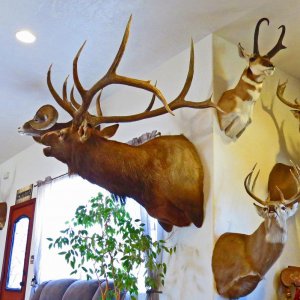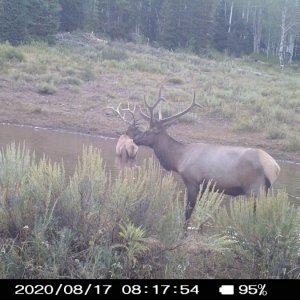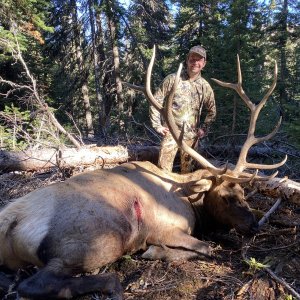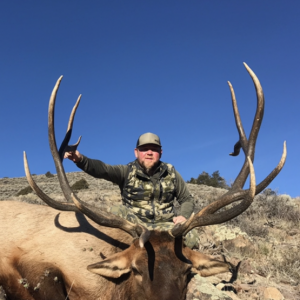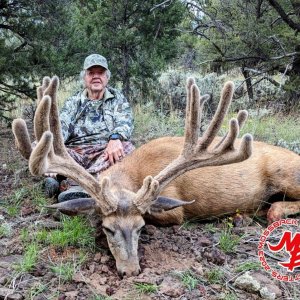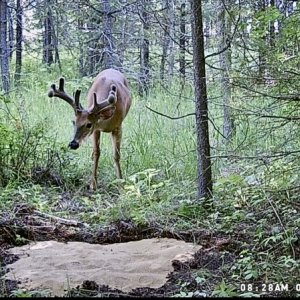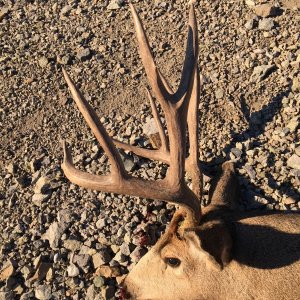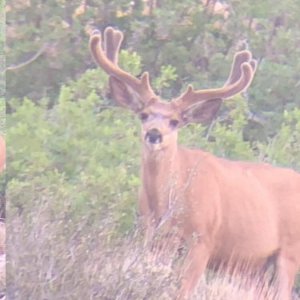You are using an out of date browser. It may not display this or other websites correctly.
You should upgrade or use an alternative browser.
You should upgrade or use an alternative browser.
Cheatgrass 101
- Thread starter elkfromabove
- Start date
txhunter58
Long Time Member
- Messages
- 8,745
Jims. Any elevation it won’t grow above?
It would make sense that it isn’t as harmful in heavy farming areas. It’s green in the winter , crops are green in the summer.
It would make sense that it isn’t as harmful in heavy farming areas. It’s green in the winter , crops are green in the summer.
elkfromabove
Very Active Member
- Messages
- 2,122
Anything for a good laugh, I see! Of course, none of the deer you show have any idea what cheatgrass is or does! That's just become a part of their life and they eat what's available when it's available. And after a winter diet of bark, twigs, hard-to-get-to-food under the snow and ice, anything green is readily eaten, regardless of its biological value.This deer looked down and saw that patch of cheatgrass in the shade of a russian olive tree. Damn near scared him to death. Add that to the list of ways cheatgrass kills.
For you fellers who don’t get to watch mule deer very much
View attachment 145493
elks96
Long Time Member
- Messages
- 3,874
I have seen it take hold up to 9500-10,000.... East of Baggs there is an area with it just over 9,500 and outside of Dubois I know an area where is it just over 10,000 feet. I am sure it is higher just cant think of places I have seen it...Jims. Any elevation it won’t grow above?
It would make sense that it isn’t as harmful in heavy farming areas. It’s green in the winter , crops are green in the summer.
txhunter58
Long Time Member
- Messages
- 8,745
I have seen it take hold up to 9500-10,000.... East of Baggs there is an area with it just over 9,500 and outside of Dubois I know an area where is it just over 10,000 feet. I am sure it is higher just cant think of places I have seen it...
Well, with cattle being hauled to the High country every year, it’s only a matter of time till those seeds get spread uphill. Also, hay is probably a method of spread as well.
Last edited:
txhunter58
Long Time Member
- Messages
- 8,745
Found this about Montezuma county in SW CO. They will cost share ($250-500 limits) for cheatgrass. Application may be accepted or turned down.
I am checking in Dolores Co, where my property is, but haven’t found anything yet.
Also map of cheatgrass in Montezuma Co

I am checking in Dolores Co, where my property is, but haven’t found anything yet.
Also map of cheatgrass in Montezuma Co
Bluehair
Long Time Member
- Messages
- 8,573
It is a false premise that a mule deer needs to be starving or malnourished to eat cheatgrass. Do you ever even watch deer?Anything for a good laugh, I see! Of course, none of the deer you show have any idea what cheatgrass is or does! That's just become a part of their life and they eat what's available when it's available. And after a winter diet of bark, twigs, hard-to-get-to-food under the snow and ice, anything green is readily eaten, regardless of its biological value.
David, the Dolores County weed board reimburses $100 for chemical. You may get it twice?
notdonhunting
Very Active Member
- Messages
- 2,294
"Wow" touchy feelings.Yup, deer like weeds (forbs). I got plenty. Just takes water.
Cheatgrass reduces the carrying capacity of the range, period. It is not toxic to deer nor do they die when they walk thru it. Solar panels will do FAR more damage to deer populations in my ‘hood.
You guys can spend every conservation and agency dollar there is on that $1000/gallon spray, and when the money’s all gone it won’t make a any more difference than a spit in the ocean to mule deer populations. Cheatgrass is only one of the 54 things causing mule deer populations to decline, but it isn’t anywhere close to the primary cause. That’s my whole point for pushing back on the hyperbole.
By all means, keep on spraying. You can start on my place. But save some of that money to develop water sources.
It is all good and fine to make light of other's opinions, "but".
There is no one making a claim that cheat grass is toxic or that deer die when they walk through it, you are the only one that keeps bringing it up.
I am 100% in agreement that solar fields are one of the biggest down fall to the environment that man kind has created. There is no one that hates solar more than me.
I will also back you on needing more water.
I personally have watched my favorite muley deer hunting honey hole completely become void of deer because of the lack of water.
And yes I belive I have saw plenty of muley deer throughout all the different seasons and what they feed on. I have seen deer eating young green cheat grass and old dry cheat grass, I have seen deer eating Juniper limbs and I have seen them eating old dry cow shiz.
Just one week ago from today, i even saw 5 head of deer eating in a green field on the south side of Highway 491, probably not ten miles from your house, and thoe I did not stop and look I am pretty certain that it was not cheat grass they was eating.
Yes there might be 54 things that is destruction of the muley deer herds of the west and I personally support most any effort to help the struggling muley deer herds of the west.
I understand it is expensive to spray your land and it is alot to expect any private land owner to take on that burden, I am not ragging on you or any land owner, but I commend anyone that dies take on that responsibility.
And most of all I do appreciate the great photographs you share with us.
Bluehair, I'm glad you brought up water development projects!
What impacts do you think acres of dense cheatgrass have on springs and ephemeral streams? If global warming and/or drought impact water availability to plants and wildlife, do you think cheatgrass induces drought conditions even more than they already are?
We have found that springs fill tanks for extended dry months and ephemeral streams run longer into the summer on our properties where we have controlled large acres of cheatgrass. Our native forbs and shrubs are also more resilient to battle dry conditions.


I took the above photo last week as an example of an ephemeral spring on one of our properties that has run with water the past couple years. The adjacent ephemeral creek beds with similar habitat and dense cheatgrass have no running water. Prior to us spraying dense cheatgrass in this area I never saw running water. The nutritious browse is also pretty incredible! Take a look at the leader growth on the mountain mahogany and other shrubs in the background.
What impacts do you think acres of dense cheatgrass have on springs and ephemeral streams? If global warming and/or drought impact water availability to plants and wildlife, do you think cheatgrass induces drought conditions even more than they already are?
We have found that springs fill tanks for extended dry months and ephemeral streams run longer into the summer on our properties where we have controlled large acres of cheatgrass. Our native forbs and shrubs are also more resilient to battle dry conditions.
I took the above photo last week as an example of an ephemeral spring on one of our properties that has run with water the past couple years. The adjacent ephemeral creek beds with similar habitat and dense cheatgrass have no running water. Prior to us spraying dense cheatgrass in this area I never saw running water. The nutritious browse is also pretty incredible! Take a look at the leader growth on the mountain mahogany and other shrubs in the background.
Last edited:
To answer your questions in regard to elevation and cheatgrass. The highest elevation we've sprayed dense cheatgrass on a large scale on our properties is approximately 8,000' elevation.
As elks96 mentioned above, I've seen cheatgrass growing at around 10,000'. It usually takes some sort of disturbance (grazing, fire, etc) for it to grow at higher elevations.
I've read in the literature that the elevation zone with cheatgrass is rising with the advent of global warming so cheatgrass is becoming a problem at higher and higher elevations. Also, with more frequent and larger-scale wildfires occurring across the West at higher elevations and different habitat zones there is better chance for cheatgrass to establish and spread.
Elevation is also relative. Laramie, Wyoming is at approximately 7,200' elevation. I know they have been spraying thousands of acres of cheatgrass areas on Curt Gowdy State Park above Laramie that is over 8,000' elevation. In the below article are some of the large-scale cheatgrass projects that are funding thousands of acres of cheatgrass control to benefit wildlife and native ecosystems in Wyoming.

 wyofile.com
wyofile.com
Below are before and after photos from a large area sprayed east of Laramie for long-term cheatgrass control that benefits wildlife and native species. Do you think muledeer, pollinators, and other wildlife would prefer the top or bottom photo? Also, would a fire burn more intensely through the top or bottom photo? The top photo is in a drought-induced state. Cheatgrass has soaked up most of the available moisture and water.

As elks96 mentioned above, I've seen cheatgrass growing at around 10,000'. It usually takes some sort of disturbance (grazing, fire, etc) for it to grow at higher elevations.
I've read in the literature that the elevation zone with cheatgrass is rising with the advent of global warming so cheatgrass is becoming a problem at higher and higher elevations. Also, with more frequent and larger-scale wildfires occurring across the West at higher elevations and different habitat zones there is better chance for cheatgrass to establish and spread.
Elevation is also relative. Laramie, Wyoming is at approximately 7,200' elevation. I know they have been spraying thousands of acres of cheatgrass areas on Curt Gowdy State Park above Laramie that is over 8,000' elevation. In the below article are some of the large-scale cheatgrass projects that are funding thousands of acres of cheatgrass control to benefit wildlife and native ecosystems in Wyoming.

Big spending needed to halt Wyoming’s ‘losing battle’ against cheatgrass - WyoFile
The governor’s $20 million request to combat invasive grasses was slashed 75% by the appropriations committee before being partly restored.
Below are before and after photos from a large area sprayed east of Laramie for long-term cheatgrass control that benefits wildlife and native species. Do you think muledeer, pollinators, and other wildlife would prefer the top or bottom photo? Also, would a fire burn more intensely through the top or bottom photo? The top photo is in a drought-induced state. Cheatgrass has soaked up most of the available moisture and water.
Last edited:
Bluehair
Long Time Member
- Messages
- 8,573
Well, we’ve learned that cheatgrass lowers the water table 12’ by the tremendous suction of it’s powerful roots. I’m looking forward to the piezometer data on that one. I can think of a dozen civil engineering applications without even trying. Then it bursts into flames.Bluehair, I'm glad you brought up water development projects!
What impacts do you think acres of dense cheatgrass have on springs and ephemeral streams? If global warming and/or drought impact water availability to plants and wildlife, do you think cheatgrass induces drought conditions even more than they already are?
We have found that springs fill tanks for extended dry months and ephemeral streams run longer into the summer on our properties where we have controlled large acres of cheatgrass. Our native forbs and shrubs are also more resilient to battle dry conditions.
View attachment 145514View attachment 145592
I took the above photo last week as an example of an ephemeral spring on one of our properties that has run with water the past couple years. The adjacent ephemeral creek beds with similar habitat and dense cheatgrass have no running water. Prior to us spraying dense cheatgrass in this area I never saw running water. The nutritious browse is also pretty incredible! Take a look at the leader growth on the mountain mahogany and other shrubs in the background.
Jims, no argument from me that it uses water. Or that there are better sources of food for animals. Serious question, do you have any pictures from the southwest part of the state? We don’t have a lot of those plants you have up there so I expect it would look a little different.
Notdonhunting, yeah this thread is kinda a burr under my skin (or in my ear). I saw more rigorous scientific analysis and common sense in the middle skool science fairs I used to help judge. There is just a TREMENDOUS amount of hyperbole and sensationalism in this thread. Yup, and I’m part of it.
Thanks for the kind words. I’ll keep on taking pictures of them eating my weeds. No hard feelings from me toward anyone posting here. We sometimes lose sight that we’re all on the same side.
I did change my avatar to more accurately reflect my mood as we spiral the bowl.
Thill
Active Member
- Messages
- 339
I have plenty in my area that is 8300+I agree on this one. I don’t recall seeing it up too high in elevation. Maybe Elkassassin can clarify on this one?
Betterluckythangood
Active Member
- Messages
- 344
I was thinking around 9000 was the highest around the salt lake area on the south slopes. But it’s just a wild guessI have plenty in my area that is 8300+
elkfromabove
Very Active Member
- Messages
- 2,122
See post #19.Chukars love it….
elkfromabove
Very Active Member
- Messages
- 2,122
No! What we learned is that cheatgrass is using so much of the water on top that less and less of it is getting down far enough to keep the water table at a steady level.Well, we’ve learned that cheatgrass lowers the water table 12’ by the tremendous suction of it’s powerful roots.
I'm simply passing along information that the many government agencies, universities, study groups and scholars have published regarding cheatgrass and its damage to wildlife and wildlife habitat. If you disagree, I suggest you find some information backing your claims!Notdonhunting, yeah this thread is kinda a burr under my skin (or in my ear). I saw more rigorous scientific analysis and common sense in the middle skool science fairs I used to help judge. There is just a TREMENDOUS amount of hyperbole and sensationalism in this thread. Yup, and I’m part of it.
Bluehair
Long Time Member
- Messages
- 8,573
What are my claims? That it’s a weed that’s not toxic to mule deer? And they eat it when they aren’t malnourished? And that there are no facts in this thread about the actual increase in the number of deer we can expect after we get done poisoning the landscape?No! What we learned is that cheatgrass is using so much of the water on top that less and less of it is getting down far enough to keep the water table at a steady level.
I'm simply passing along information that the many government agencies, universities, study groups and scholars have published regarding cheatgrass and its damage to wildlife and wildlife habitat. If you disagree, I suggest you find some information backing your claims!
Sure, I’ll go along with that.
Spray away. I made a damn good living cleaning up the messes left behind by zealots driven by special interests. Somebody else deserves a chance.
elkfromabove
Very Active Member
- Messages
- 2,122
"I saw more rigorous scientific analysis and common sense in the middle skool science fairs I used to help judge. There is just a TREMENDOUS amount of hyperbole and sensationalism in this thread. Yup, and I'm part of it."What are my claims?
-"What is cheatgrass & how is it harmful"- USGS
-"Why Is Cheatgrass Bad"- Working Lands for Wildlife
-"Cheatgrass The Evil Weed"- Ellensburg Animal Hospital
-"Cheatgrass Threatens Wildlife, Western Lands and Rural Communities" - National Wildlife Federation
-"A Homeowner's Guide to Cheatgrass" - Univ of Nevada Reno
-"How To Get Rid of Cheatgrass In Your Yard"- Invasive Garden
-"Got Cheatgrass? Here's how to kill it and get your pasture back" - Beef Magazine
- "CHEATGRASS MANAGEMENT HANDBOOK"- Univ of Wyoming-Colorado State Univ.
- "Cheating the Sage, and the Fight Ahead for Mule Deer and Hunters."- Mule Deer Foundation Journal
I could go on but I'm hoping the readers will do some of their own homework. There are MANY more articles and none of them (as far as I've found) are very favorable to cheatgrass or want to keep it as is.
Ask An Expert: Mike Pellant, Rangeland Ecologist (retired), Bureau of Land Management
Learn more through this NEW webinar series: Moving the Needle on Cheatgrass: Putting What We Know into PracticeWhat is cheatgrass?
It’s an annual invasive grass that is native to Europe and eastern Asia, not North America. It was brought over by European settlers in the mid to late 1800s.
It probably wouldn’t have outcompeted native vegetation if early settlers hadn’t also introduced large numbers of livestock like cattle and sheep into sagebrush country. Our palatable native grasses and forbs weren’t adapted to those high levels of uncontrolled overgrazing by domestic livestock, which created a void that cheatgrass quickly filled.
Cheatgrass is now found in at least 49 states, although it’s mainly a problem in the semi-arid Great Basin — which stretches across portions of Utah, Nevada, Idaho, Oregon, and California — since its adapted to thrive in areas with wet winters and hot, dry summers. People are now used to seeing cheatgrass-dominated landscapes, but it’s not what we should see.
Cheatgrass is an annual invasive plant that crowds out native plants in sagebrush range.
Why is it bad?
Cheatgrass dries out much earlier than native vegetation, significantly lengthening the historic fire season. Plus, cheatgrass has very fine leaves and stems, which makes it ignite easily and causes fire to spread rapidly. Cheatgrass plants also grow very close together (up to 10,000 plants in a square-meter), creating a continuous fuel base. Basically cheatgrass is comparable to tissue paper covering the landscape — an easily-ignited fuel that carries fire quickly and spreads it rapidly.
Since native plant communities aren’t adapted to frequent wildfires, these fires create even more cheatgrass-dominated rangelands. Cheatgrass is adapted to efficiently use the increased nitrogen in the soil after a fire, and invades empty spaces created by the fire.
Cheatgrass creates a vicious cycle: wildfires promote more cheatgrass, which in turn further increases the impacts and probability of wildfires.
How does cheatgrass impact wildlife and range health?
It short-circuits a lot of the important ecological cycles. For example, cheatgrass has a shallow root system — most of the roots are concentrated in the top 12 inches of soil, so it absorbs much of the water and nutrients during the spring growing season, outcompeting native plants for limited resources.
The loss of native plants means losing their deeper roots systems, which create healthy soil. Roots of sagebrush and other native shrubs can grow up to eight feet deep, helping to cycle nutrients and utilize water deeper in the soil profile. Cheatgrass also affects the diversity and abundance of soil microorganisms, which may reduce the ability of native plants to grow in the future.
As for wildlife, the biggest threat from cheatgrass is the loss of habitat due to increased wildfires and the conversion of diverse native plant communities to monocultures of an annual grass. In addition, cheatgrass doesn’t meet the needs of most wildlife species. It doesn’t stay green long enough to provide nutritious forage during the summer and fall, nor does it provide the vegetation structure that many species need for cover or nesting habitat.
How big of a problem is it?
I found a report dated back to 1905 that the U.S. Forest Service sent to Congress recognizing cheatgrass as an emerging problem. Aldo Leopold wrote an essay in the 1940s called “Cheat Takes Over.” He could see into the future, warning us to watch out for this invasive weed.
Sadly, he was right. Now cheatgrass is one of the biggest invasive species problems in the western U.S., estimated to cover 50-70 million acres. The magnitude of the problem tends to overwhelm us.
Bluehair
Long Time Member
- Messages
- 8,573
"I saw more rigorous scientific analysis and common sense in the middle skool science fairs I used to help judge. There is just a TREMENDOUS amount of hyperbole and sensationalism in this thread. Yup, and I'm part of it."
-"What is cheatgrass & how is it harmful"- USGS
-"Why Is Cheatgrass Bad"- Working Lands for Wildlife
-"Cheatgrass The Evil Weed"- Ellensburg Animal Hospital
-"Cheatgrass Threatens Wildlife, Western Lands and Rural Communities" - National Wildlife Federation
-"A Homeowner's Guide to Cheatgrass" - Univ of Nevada Reno
-"How To Get Rid of Cheatgrass In Your Yard"- Invasive Garden
-"Got Cheatgrass? Here's how to kill it and get your pasture back" - Beef Magazine
- "CHEATGRASS MANAGEMENT HANDBOOK"- Univ of Wyoming-Colorado State Univ.
- "Cheating the Sage, and the Fight Ahead for Mule Deer and Hunters."- Mule Deer Foundation Journal
I could go on but I'm hoping the readers will do some of their own homework. There are MANY more articles and none of them (as far as I've found) are very favorable to cheatgrass or want to keep it as is.
eelgrass
Long Time Member
- Messages
- 32,051
There's something unsettling about watching a deer eat grass. That must be what I look like when the wife plates up Brussel Sprouts.
elkfromabove
Very Active Member
- Messages
- 2,122
It's green and I said they'll eat what's available when it's available.
Bluehair
Long Time Member
- Messages
- 8,573
Well, just to prove I’m on Team Spray*, this would be my plan if I was king for a day here in Colorado.It's green and I said they'll eat what's available when it's available.
In spite of my distrust of the Deep State and all the bureaucrats pumping out agenda driven initiatives, my distaste for the Liberal-Educational Complex that pumps out misinformation to support those bureaucrats, and my xenophobic paranoia of foreign owned Big Biotech vax-profiteering boogie men (Bayer AG in this case) and science in general, I would propose that $.15 of the search and rescue fee go toward rangeland rehabilitation projects.
I feel like this would be a much better investment than retrieving numbskulls from 14’ers in a blizzard. And if the people lovers object, then fund the S&R shortfall (does anyone really believe this isn’t a cash cow?) from the MILLIONS that were obtained deceptively through the State Parks Pass ripoff of your grandma.
Of course this would require a bunch of bureaucratic pushups in the form of inter-agency agreements and such, but it’s a worthy cause and something everyone can get behind. We could even charge non-residents double. Of course this would only solve the problem in Colorado.
*And I would make you all read Silent Spring. Yup, that’s what I would do if I was King for a day.
2lumpy
Long Time Member
- Messages
- 8,621
I understand your comments, I won’t call them your arguement because you’re clearly not opposed to removing cheatgrass. As you said, it is but one of some 54, more or less reasons our mule deer are in decline. So I’m going to comment on the frustrations I carry with me when it comes to the wildlife management burearcrats.Yup, deer like weeds (forbs). I got plenty. Just takes water.
Cheatgrass reduces the carrying capacity of the range, period. It is not toxic to deer nor do they die when they walk thru it. Solar panels will do FAR more damage to deer populations in my ‘hood.
You guys can spend every conservation and agency dollar there is on that $1000/gallon spray, and when the money’s all gone it won’t make a any more difference than a spit in the ocean to mule deer populations. Cheatgrass is only one of the 54 things causing mule deer populations to decline, but it isn’t anywhere close to the primary cause. That’s my whole point for pushing back on the hyperbole.
By all means, keep on spraying. You can start on my place. But save some of that money to develop water sources.
Yes, it goes back 50 years because that’s when all this started, back when all western States, accept Nevada, were teeming with mule deer. 50 years ago hunters and the public, during public wildlife hearing, all that was discussed was how can we get rid of some of these damn mule deer. Now……. that is a fact, and those few folks that are still alive know that is factual.
So what?
So…. here is another fact, all 54 +\- ( which I agree there are 54 *\- ) that you claim are reasons for the declining mule deer didn’t happen all in one year, and it didn’t happen in every State simultaneously. That is exactly where we are today.
As crazy guys like me, that spent ever free minute we had on the summer and winter range, doing ranch rides with the bureaucrats, riding along on fall population counts, socializing with biologists and law enforcement officers, who in those days were our neighbors and good friends…… we began to see changes in the mule deer numbers. We started hearing from non-State bureaucrats, specifically Professors from our State’s universities’ wildlife departments, Federal land agency biologists, and even a couple of private land owners non-government biologists. These non State people began to express concerns about the mule deer herd conditions. These expressed concerns were, in fact, why South Central Utah sportmen pushed for and were granted by the Wildlife Board, the dreaded antler restriction regulation in 1984. That specific sportsmen’s uprising started directly from concerns that biologists from the local BLM Office came to sportsmen about. (Federal biologists are not invited to give opinions on big game species in State public wildlife hearings, then or now.)
The changes taking place in mule deer numbers were very clearly pointed out to the State bureaucrats, year after year after year after year. Each year, each public hearing, each private meeting, each napkin writing lunch was met with more and more hostile resistance. There has never been a time, in the last 50 years, that numerous entities, from sportsmen’s clubs/organizations, Federal agencies, little old ladies, with cabins on the mountain and in the winter range haven’t gone to the bureaucracy and been turned away….. with growing angst.
Now, after 50 years of accumulating reasons for declining mule deer populations, the bureaucrats crying out……… “What do you want us to do, there’s far too many problems, mule deer populations will never be the same.”
I say…….. if the bureaucrats would have dealt with these issues, as they occurred, one after the other, in a timely manner, rather than getting all pissed off, and defensive with sportsmen, legislators, and little old ladies……. far more could have been done. Instead…… they denied, denied and denied some more…… that the mule herd was in decline.
Bottom line, for me is, the 54 issues came slowly, over 50 years, and over those 50 years the bureaucrats not only didn’t offer solutions but in fact circumvented and subverted every effort by anyone and everyone…… to stop the decline of mule deer.
Now…… here we are with a fraction of the once large and healthy population of mule and 54 different problems to fix and not a clue how to do it.
Yes, it makes me furious.
Last edited:
elkfromabove
Very Active Member
- Messages
- 2,122
SO, here we are! There are MANY things that should have happened but didn't. So, what are we to do next? As I look around at all the situations that exist in the western states, I can only make a few common connections that humans can control and controlling cheatgrass to me is the most obvious. It is already beginning in several states and appears to be effective and I, for one, believe it is our best hope for the future of mule deer and mule deer hunting.Now…… here we are with a fraction of the once large and healthy population of mule and 54 different problems to fix and not a clue how to do it.
Yes, it makes me furious.
2lumpy
Long Time Member
- Messages
- 8,621
I personally am not going to do one damn thing EFA. Every time I have done anything, so far a concerted effort I have made it worse. That too is an absoluteSO, here we are! There are MANY things that should have happened but didn't. So, what are we to do next? As I look around at all the situations that exist in the western states, I can only make a few common connections that humans can control and controlling cheatgrass to me is the most obvious. It is already beginning in several states and appears to be effective and I, for one, believe it is our best hope for the future of mule deer and mule deer hunting.
fact. I have also encouraged my children and grand child to find different and better ways to keep their passion for hunting alive. It’s blatently obvious the bureaucrats in Utah are not going to respond in any positive way.
Is I’ve said repeatedly on this Forum but no where else, units need to be closed and rehabilitated to their specific 54 needs and a continuous rotating bases…… but that will never happen in any of my current families life time. And once again, to the young hunters……. start laying the ground work to hunt private property if your going to hunt deer…….. mule deer or whitetails. It will be your only option.
elkfromabove
Very Active Member
- Messages
- 2,122
Except for reducing carbon sequestration which is long term and not easily attached to habitat and some on-going studies to determine how this plant may effect soils, ground bacteria, mosses, lichens and enzymes, I think the class is over! I've tried to cover everything* I know about it, but If I (or you) think of anything else or if you have questions, let me know.
Lee
*Basically, I've just passed on some knowledge I've learned from others.
Lee
*Basically, I've just passed on some knowledge I've learned from others.
I've pretty much just touched the surface of all of the detailed cheatgrass research we've conducted the past 10ish years. I thought I would add another sample in this post.
We have a new publication in the works looking at preference of mule deer to areas where dense cheatgrass has been controlled and native browse species have been released from cheatgrass competition. We set up game cameras on replicated sites on a couple properties. Game cameras were set up in areas we've had long-term cheatgrass control vs immediately adjacent nontreated sites with dense cheatgrass.
Below is a photo of one of the sites we set up paired game cameras. The green area on the left side of the road is obviously where cheatgrass was removed and native browse species dramatically increased. This photo was taken just one year after treatment. You can already tell the size of the shrubs on the left side are larger and greener than the suppressed shrubs in dense cheatgrass on the right.
How much time do you think the deer will spend browsing on the left side of the road vs the right?

We have a new publication in the works looking at preference of mule deer to areas where dense cheatgrass has been controlled and native browse species have been released from cheatgrass competition. We set up game cameras on replicated sites on a couple properties. Game cameras were set up in areas we've had long-term cheatgrass control vs immediately adjacent nontreated sites with dense cheatgrass.
Below is a photo of one of the sites we set up paired game cameras. The green area on the left side of the road is obviously where cheatgrass was removed and native browse species dramatically increased. This photo was taken just one year after treatment. You can already tell the size of the shrubs on the left side are larger and greener than the suppressed shrubs in dense cheatgrass on the right.
How much time do you think the deer will spend browsing on the left side of the road vs the right?
Last edited:
This study was designed to evaluate deer preference to cheatgrass vs sites where cheatgrass was controlled using game cameras. We also monitored native forbs, shrubs, grass, and cheatgrass biomass at these same paired sites.
Photos were totaled monthly of deer that were actually browsing rather than just walking through sites. The table below is the means/month the first year of this study. We monitored game cameras at these sites for 3 years in this study.
As you can see in the table below, the deer on this particular property were mostly present on the winter range from October through May. Does generally headed to higher ground to give birth to their fawns. Cheatgrass generally emerges in the early fall and is generally present from October through May at these sites. As you can see there is a strong preference of mule deer for sites where cheatgrass has been removed with more nutritious browse than cheatgrass.
Mule deer were present and browsing in areas with more nutritious browse 2 to 4 X compared to adjacent sites with dense cheatgrass. We also sampled pellet counts with quadrats along replicated transects on these same cheatgrass vs adjacent sprayed sites. The pellet count data mirrored what we found with game cameras.

Below is the average number of deer photos/month during the first year of this study in dense cheatgrass vs adjacent sites where cheatgrass was controlled by Rejuvra. As you can see in the table below, mule deer on winter range spent 4x times more time browsing areas with highly nutritious browse that was released where cheatgrass was controlled.

Photos were totaled monthly of deer that were actually browsing rather than just walking through sites. The table below is the means/month the first year of this study. We monitored game cameras at these sites for 3 years in this study.
As you can see in the table below, the deer on this particular property were mostly present on the winter range from October through May. Does generally headed to higher ground to give birth to their fawns. Cheatgrass generally emerges in the early fall and is generally present from October through May at these sites. As you can see there is a strong preference of mule deer for sites where cheatgrass has been removed with more nutritious browse than cheatgrass.
Mule deer were present and browsing in areas with more nutritious browse 2 to 4 X compared to adjacent sites with dense cheatgrass. We also sampled pellet counts with quadrats along replicated transects on these same cheatgrass vs adjacent sprayed sites. The pellet count data mirrored what we found with game cameras.
Below is the average number of deer photos/month during the first year of this study in dense cheatgrass vs adjacent sites where cheatgrass was controlled by Rejuvra. As you can see in the table below, mule deer on winter range spent 4x times more time browsing areas with highly nutritious browse that was released where cheatgrass was controlled.
Last edited:


